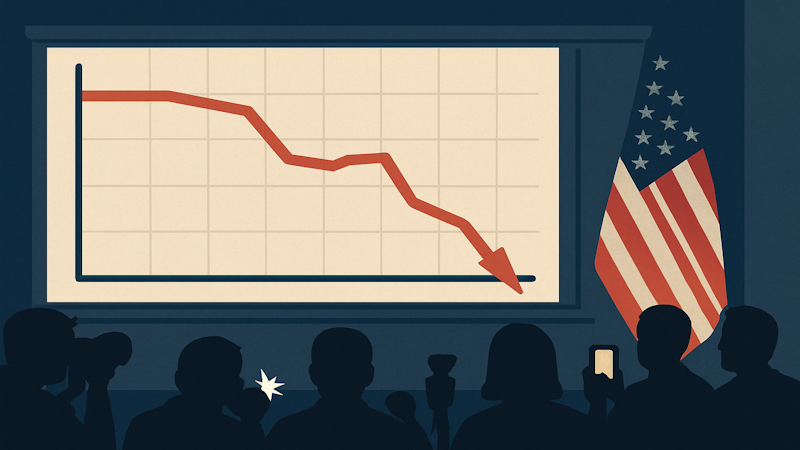When the Messenger Gets Shot
BLS Firing Doesn't Hide the Real Labor Market Crisis

August 12, 2025
Last Friday, President Trump fired Bureau of Labor Statistics Commissioner Erika McEntarfer just hours after her agency released devastating jobs data—only 73,000 jobs added in July, with massive downward revisions slashing 258,000 jobs from previous months. Trump claimed the numbers were "rigged" and accused McEntarfer of "faking" data to make him "look bad."
But here's what the political theater is missing: the numbers aren't rigged—they're revealing. Behind the statistical noise lies a fundamental transformation of American labor markets that no commissioner, fired or otherwise, can hide. The convergence of demographic shifts, immigration restrictions, and trade wars has created a perfect storm that's reshaping work as we know it.
The Numbers Don't Lie—They Warn
The weak July report isn't an anomaly—it's a symptom of deeper structural changes that have been building since February. 11,000 baby boomers retire daily while Gen Z surpasses them in workforce participation. 700,000+ workers lost legal status through immigration policy changes including TPS terminations and 287(g) program expansion. Tariffs reaching 145% triggered supply chain disruptions and manufacturing job losses despite "reshoring" promises.
Source: Bureau of Labor Statistics, JOLTS data
Labor force participation vs. job openings since COVID's low point shows a widening gap—demand for workers recovered faster than supply, creating the structural imbalance we're seeing today. These aren't partisan talking points or statistical manipulation. They're the measurable consequences of policy choices colliding with demographic reality. And small businesses are bearing the brunt.
The Recruiting Reality Check
Small business owners are living this crisis every day.
Your best server just gave two weeks' notice for a $2/hour raise somewhere else. The Indeed posting that used to get 50 applications now gets 12—and half don't show up for interviews. You're paying ZipRecruiter $300/month to hire "ghosts"—people who accept the job, work two shifts, then disappear.
Meanwhile, your remaining team is burning out covering extra shifts. You're turning down business because you can't staff it. The reliable pipeline of referrals from current employees has dried up because everyone they know already has a job. You're competing against Amazon warehouses offering $18/hour with benefits you can't match.
Source: Bureau of Labor Statistics, Current Population Survey
Underemployment data reveals the hidden challenge—skilled workers taking jobs below their qualifications while high-skill positions remain vacant, showing it's not just about quantity but quality of labor matching.
But here's what big companies with all their resources can't replicate—your Underdog Principles.
Positioning: Unlike Walmart hiring for "any store," you can hire for your specific business. Find people who actually want to work in a bike shop, not just anywhere that pays $15/hour.
Proximity: You know your employees' kids' names. Use that closeness to create flexible schedules around their lives—something impossible in corporate HR systems.
Purpose: Offer what no corporate job can—direct mentorship from you, clear advancement paths, and the chance to shape something meaningful.
Source: NFIB Small Business Economic Trends
NFIB data shows small businesses face the double squeeze—89% report hiring difficulties while turnover rates remain elevated, creating a costly cycle of constant recruiting. The businesses succeeding aren't just paying more—they're leveraging advantages that money can't buy.
The New Labor Market Reality
Current market conditions reveal persistent structural challenges. Unemployment steady at 4.2% but job creation weakest since 2016. 7.4 million job openings but sector-specific shortages creating acute pressures. Real wages up 4.6% annually for median workers, but geographic disparities widening. Nevada (5.7%) and Michigan (5.5%) facing highest unemployment while Dakotas maintain near-full employment.
This isn't a temporary dip that better statistics or new commissioners can fix. It's a structural shift requiring businesses to fundamentally rethink how they attract, develop, and retain talent.
Without targeted interventions—predictable trade policies, small business financial assistance, workforce development programs—widespread small business failures could eliminate millions of jobs and reduce economic dynamism.
Take Even Better Care of Your Employees
The labor market isn't just competitive anymore—it's existential. In 2025, losing a good employee doesn't just mean posting another job listing. It means questioning whether you can keep your doors open.
Build relationships before you need them: Your current employees are your only reliable recruiting channel when traditional hiring fails. That restaurant owner who stopped posting job ads? She asks her best employees if they know anyone looking for work. These referred candidates already understand the job demands and culture, and they're more likely to stick around because they have a built-in connection to the team.
Invest in retention, not just recruitment: Six months of operating capital for retention bonuses is cheaper than six months of being understaffed. A local retail shop created a unique role for a talented employee who needed to care for an aging parent—combining morning inventory work with afternoon customer service in a split shift that worked for everyone. This kind of customization isn't possible in larger organizations where roles are standardized.
Create flexibility that big companies can't match: Split shifts, job customization, direct mentorship—these are small business superpowers. Think about it from an employee's perspective: Would you rather be employee #1,457 at a giant corporation or one of twenty people learning directly from the owner of a successful small business?
The commissioner who gets fired doesn't change the underlying numbers. The labor market has shifted permanently, and small businesses that adapt to this reality won't just survive—they'll thrive when their less-prepared competitors can't keep their teams together.
Don't wait for the next jobs report to tell you what you already know. Start building your people advantages today.
Copyright 2025
Sri Kaza
